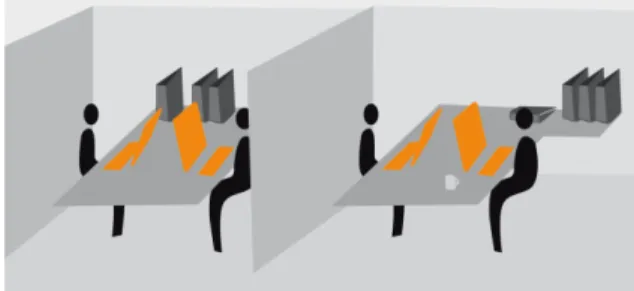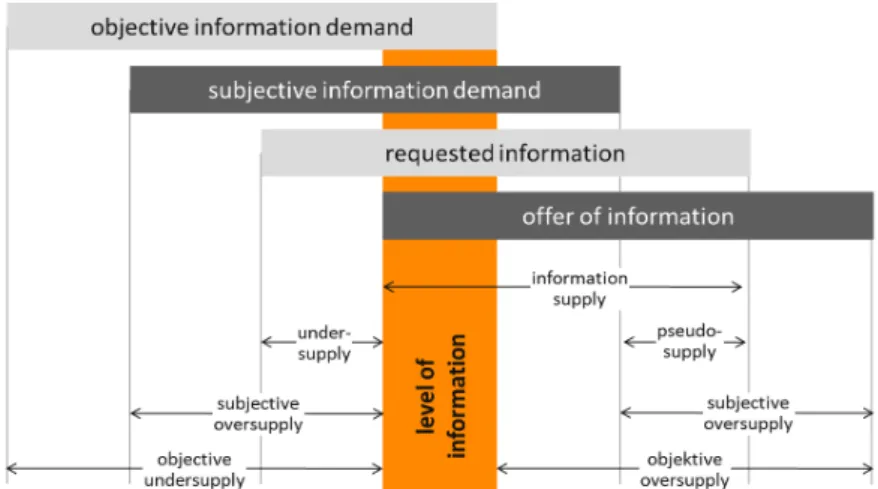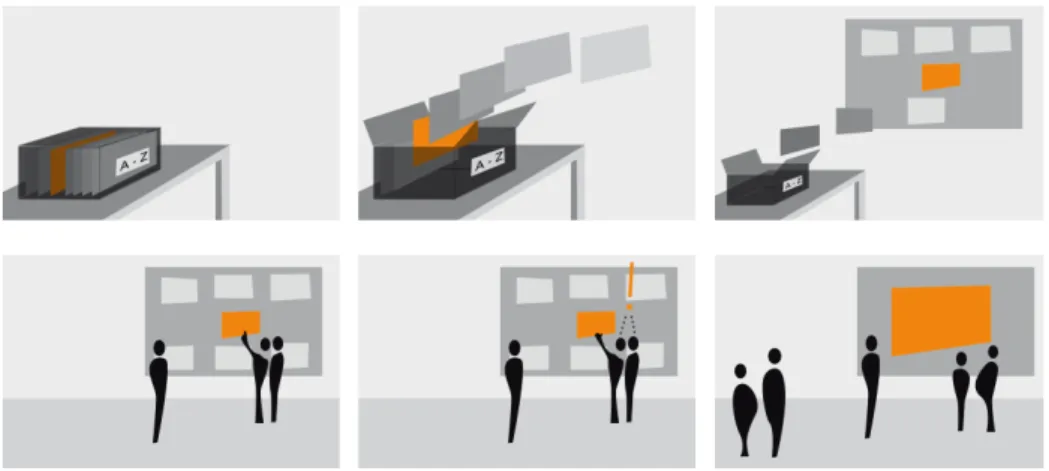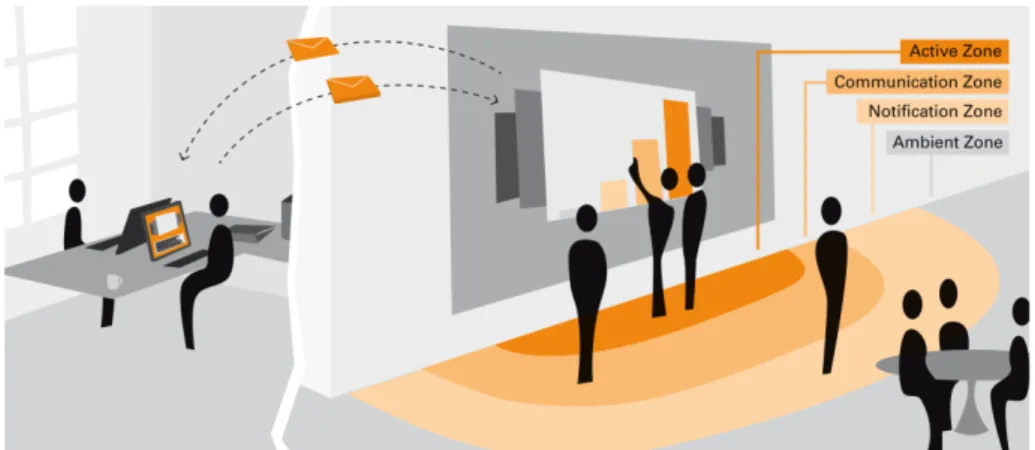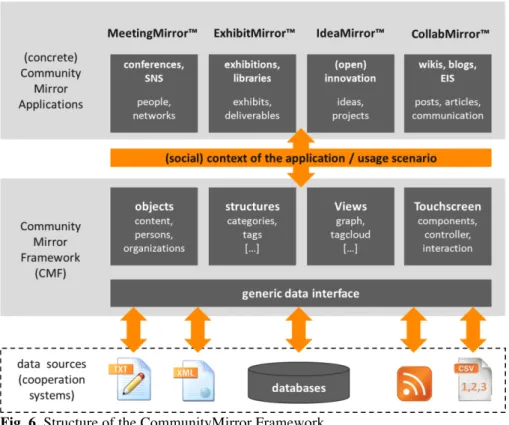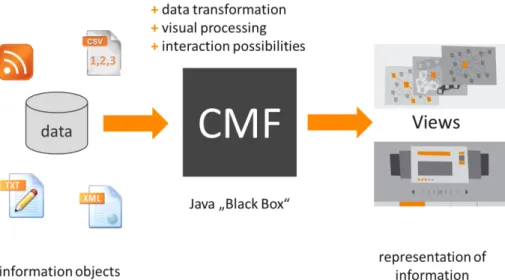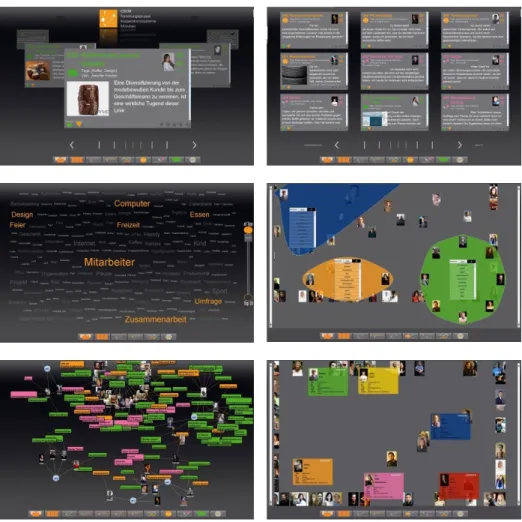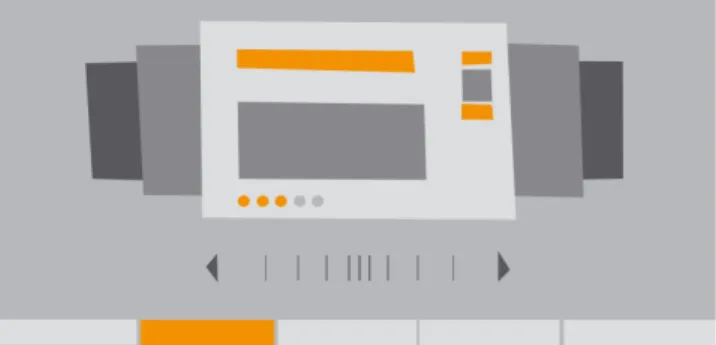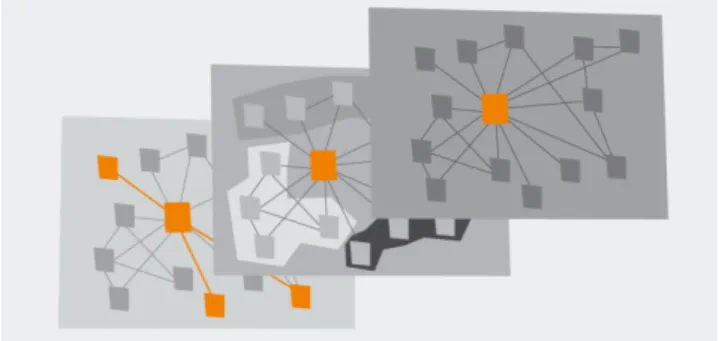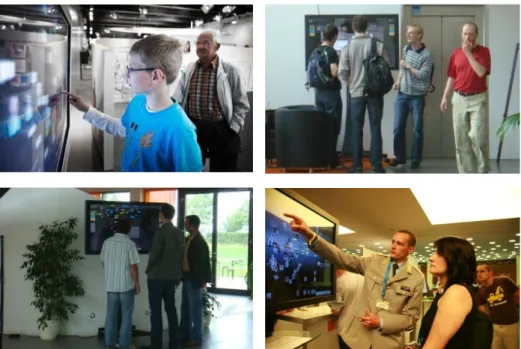Communities with CommunityMirrors™
Michael Koch, Florian Ott, Alexander RichterCooperation Systems Center Munich (CSCM) Bundeswehr University Munich
Werner-Heisenberg-Weg 39 85579 Neubiberg, Germany michael.koch@unibw.de
Abstract.
Community support is continuously gaining more and more importance, especially in areas where inter-human communication is a critical success factor, e.g. in knowledge management. One important issue concerning community support is making the community and the activitiy in the community visible to its members. Knowing better what other community members know and do can help to improve information supply by making information that is usually “hidden” inside of today’s IT systems available to the community and to outsiders. In this chapter we present an approach, which helps to make community awareness information visible in a socio-technically integrated, interactive way. The concept is based on large touch screens or interactive projections in semi-public places like lobbies or coffee corners. These socio-technical systems, called CommunityMirrors, help people to see, touch and experience digital content, and find information by chance without having to look for it explicitly. Intuitive presentation and interaction possibilities on large touch screens improve the visibility of information, the awareness about what is happening in the underlying systems and corresponding communities, and last but not least generate appreciation for information providers. Moreover, through the integration into the social context CommunityMirrors support inter-human communication between users standing in front of the screens and enhance the motivation of information providers for the generation of new content.
Keywords: Ubiquitous Computing, Community Support, Human Computer Interaction, Socio-technical Integration, Awareness, Open Innovation, CommunityMirrors™, Natural User Interface
1
Introduction
Starting from early studies in the domain of computer-supported cooperative work, community support is continuously gaining more and more importance in enterprises, especially in areas where inter-human communication is a critical success factor, e.g. in knowledge management. First community platforms, mainly based on bulletin boards, tried support the so-called “WE-mentality” by giving communities of
employees and customers a virtual place, where they could work together and communicate with each other. Recently, the ideas of the Web 2.0 found their way into enterprises, now supporting the “ME-mentality” of the employees by providing Social Software, and changing structures towards an Enterprise 2.0 (Koch, 2008, Koch and Richter, 2008). One of the most relevant application areas in this context is knowledge management where community support platforms can help so-called “communities of practice” to efficiently communicate, exchange information, or find experts (see for example Wenger, 1998).
The success of community support systems like forums, multi- and micro-blogging platforms or social networking services, depends on the active participation of a significant percentage of the community members. Hence, the availability and modality of access to the community support system can be considered a major issue. However, till now community support systems still are accessed mainly with desktop computers at home or at the workplace.
Ubiquitous Computing, i.e. new user interfaces that are embedded in the real world, can address the boundaries of community support and offer possibilities for enlarging the reach of community support systems.
Another issue where (additional) ubiquitous user interfaces to community support systems might help is overcoming the isolation of the users participating in the systems. As mentioned before, people are usually sitting in front of their desktop computers in separate locations as shown in Fig. 1.
Fig. 1. Today’s typical desktop systems
This missing socio-technical integration causes original inter-human communication to be artificially digitalized by using computer systems. At the moment this is exactly what many organizations are facing with community platforms and Social Networking Services like e.g. facebook: instead of talking to each other (which can be a very creative process concerning the generation of new ideas (Lampe et al., 2006)), even office neighbors tend to rather use digital communication instead of just walking to the next office (Richter and Riemer, 2009).
Ubiquitous and mobile computing approaches, i.e. innovative user interfaces that are integrated into the real world, can address these social boundaries of existing community support and thereby not only enlarge the scope of the used platforms (e.g. (Bardram et al., 2006), (Huang and Mynatt, 2003)), but also take care of the necessary integration of the interfaces into the social context.
By providing information access for dynamic groups of people at semi-public places in addition to single user desktop scenarios like shown in Figure 1, new
ubiquitous user interfaces can improve the visibility and ease of access to valuable information, and thereby enhance the community support. The concept of the so-called CommunityMirrors as large interactive screens tries to present a method
─ for improving the visibility of content from community support systems,
─ for distributing peripherally recognizable information in enterprises and thereby
─ increasing the awareness between employees as well as
─ for integrating the community support systems into the daily social context, and finally
─ for providing meaningful and sustainable deployment scenarios for the available new hardware.
To achieve this, CommunityMirrors provide a ubiquitous socially integrated Natural User Interface for cooperation systems or metaphorically spoken an additional ubiquitous window into IT systems. CommunityMirrors are built using large touch screens or projections in public spaces showing information that is otherwise hidden inside of open innovation systems, social networking services or other community platforms.
In this chapter we explain the theoretical concept behind CommunityMirrors and our model of social integration (Section 2 and Section 3). Afterwards, we describe the basis for the first prototypes, the CommunityMirror Framework (Section 4), and give a brief overview of two already implemented prototypes, as well as possible deployment scenarios. The paper is completed by some comments on evaluations we already have performed, a final conclusion and the discussion of some future prospects (Section 5).
2
Community Support and Community Awareness
2.1 Communities and Community Support
In general a community is a group of people who share some interest, identify with a common idea or share some work practice (see for example Hillery, 1955, Mynatt et al., 1997). Recent characterizations of the concept further highlight the need for mutual collaboration in the community, e.g. the will to exchange knowledge or to help each other (Ishida, 1998, Wenger, 1998). According to this discussion a community should not just be seen as a set of people who have something in common, and who have the possibility to communicate, but rather as a set of people who are willing to help each other, and who are collaborating to benefit from each other. Because of this, communities and community support have become a core concept in most modern knowledge management efforts.
Besides the collaboration among the members, the main activities in communities are communication as well as the search for people to communicate with. Hence, community support can be described as “communication and matchmaking support”. Correspondingly, the functionalities of computer-based community support tools can be summarized by the following two basic support concepts:
─ Providing a medium for direct communication and for indirect exchange of content and comments within the common scope of the community.
─ Providing awareness of other members, and helping to discover relationships (medium for matchmaking). This can help to find possible cooperation partners for direct interaction (see for example related work on expertise management, Becks et al., 2004, Zhang and Ackermann, 2005).
2.2 Common Ground and Community Awareness
One important issue in community support is the support of informal communication as a basis for establishing common ground that is necessary for meaningful conversations and relationships. Common ground, as Clark defines it in his book “Using Language” (Clark, 1996), is information that two parties share and are aware that they share. According to Clark, “Everything we do is rooted in information we have about our surroundings, activities, perceptions, emotions, plans, interests. Everything we do jointly with others is also rooted in this information, but only in that part we think they share with us.”.
Closely related to common ground is the concept of awareness, which has already been researched intensively in the collaboration support domain. Dourish and Belotti define awareness as “an understanding of the activities of others, which provides a context for your own activities” (Dourish and Belotti, 1992). Context for the own activities can be different types of information, ranging from information about the availability of co-workers to notifications about people or information that might be relevant to your own work or leisure activities. Schlichter et al. regard providing awareness as the most common dominator in collaboration support (Schlichter et al., 1998). They list contact facilitation and collaborative usage of knowledge as the main activities in communities to be supported by awareness. While groupware focuses on workspace awareness, community support systems focus on people/presence awareness (due to the lack of a common workspace).
2.3 Public Shared Displays for Community Support
Common ground and awareness suggest that providing a detailed and aggregated view of a community, and the information generated by the community members can help other community members in their activities. The value of awareness can be seen in lowering communication and coordination costs (by making information available, and by enabling implicit coordination) as well as concerning communities especially in supporting different forms of intrinsic motivation (appreciation through awareness). The motivation of some people relies on the possibility to be seen, and on the transparency that their contribution is being recognized in the community.
Looking at the aforementioned bulletin-board based desktop community support systems there is a clear deficit in awareness support – especially in providing peripherally recognizable awareness information to people who are not actively looking for it. The awareness about the community and about what information collected in it has to be brought back to the community, ideally in a form that makes immediate discussion by the community members possible.
Our idea to better support the existing process is to use ubiquitous natural user interfaces as additional windows into community support systems. In the following section we address the issue from a more generic point of view – to come back to the CommunityMirror application later.
3
Concept of Ubiquitous Natural User Interfaces
Since using socially integrated Natural User Interfaces for community support systems to enrich information supply is a rather new approach, we provide a brief theoretical background about the basic concepts in this section.
3.1 Enriched Information Supply through Serendipity
Today’s IT systems are usually build on applications that take input from desktop computers and store them on server systems. Looking at the storage process, information is traditionally collected and stored piece by piece. Even today’s IT systems still store pieces of information as they were written down on index cards, and kept away in a filing cabinet.
Theoretically, a once generated piece of information is completely accessible via search functionalities. However, there is a clear deficit regarding the visibility of the stored content, i.e. users sitting at their offices as shown in Fig. 1 are not aware of all the information being stored. In community support systems this lack of visibility of valuable content is particularly relevant.
Looking at the information retrieval process from a theoretical point of view a user who has a defined (subjective) information demand will normally opt for a series of keywords, which he enters into a search form. Compared to index cards, this corresponds to manually thumbing through all cards to the desired letter or category. This approach may possibly not be successful, mainly for two reasons:
1. The requested piece of information has not been supplied because it does not exist in the system. In this case we have a (real) kind of information undersupply. 2. The searched keywords, which have been chosen by the user (corresponding to his
subjective background knowledge), do not match the keywords an omniscient independent observer would have chosen. Because of that, the subjective information demand does not match the objective information demand, which would have been required for a successful information request (see Fig. 2).
Fig. 2. Information supply, inspired by (Hannan, 2006)
Given the already mentioned relentless growth of offered information, the first case is meanwhile rather rare. Instead it is more likely that the information returned for a particular information request is so far beyond the subjective information demand that the seeked information disappears in the pseudo-supply of offered information.
New approaches like semantic search or tagging indeed offer a small improvement to the relevance of search results, however they do not change the basic situation that explicit search is needed.
To be able to break out of that vicious circle even in times of growing information supply one approach can be to not only make information findable through search mechanisms at desktop computers, but to rather provide a ubiquitous information display where all information from a field of interest is displayed at once. This approach is especially helpful for information that is not searched deliberately, but profits a lot from being displayed and consumed peripherally, like e.g. ideas from innovation management systems. Thereby, CommunityMirrors can contribute to the generation of serendipity (Hannan, 2006, Roberts, 1989), which in general means finding information accidentally without having to look for it explicitly.
Robinson and Stern point out that “much creativity is the result of informal poking around, experimenting and exploiting the unexpected. In the race for the reward, not only is creativity sacrificed, but opportunities for what cognitive psychologists call ‘incidental learning’, the important knowledge and insight gained from such exploration, are greatly reduced.” (Robinson and Stern, 1997). Based on that argumentation, an ubiquitous natural user interface for cooperation systems should generate a kind of serendipity effect in order to be seen as a useful improvement for information supply. The goal obviously cannot and should not be a complete alternative to desktop computers, but rather an amendment to existing systems which is also able to support awareness, and generate appreciation for information providers as shown in the following chapter.
3.2 Information “out-of-the-box”
With our CommunityMirror approach we try to break the described existing paradigms of classical IT systems by extending them with additional wall-sized touch screens that are installed at different semi-public places throughout the organization.
Fig. 3. CommunityMirror Approach
By providing easy to use and peripherally recognizable displays for existing systems as lightweight “mirrors”, we are seeking to increase the visibility of the contained information, generate the serendipity effect described above and provide appreciation for the contributors through supporting awareness about what is going on in the platforms (Koch et al., 2004). While applicable for different kinds of information, the concept is especially valuable for community support systems to provide better access to the community awareness information discussed in Section 2.
As depicted schematically in Fig. 3 possible places for installing the mirrors can be lobbies, next to the elevator, or coffee corners, where people usually come together open-minded. At these locations they can see, touch and experience the normally “hidden” content and find information by chance without having to look for it explicitly. Far from being just another search engine CommunityMirrors are screens, which present all information from a field of interest at once in order to support awareness and serendipity. Possible visualizations can include information about people, ideas, images or maybe just feedback for a new project.
Fig. 4. Information “out of the box”
The size and visibility of a CommunityMirror allows acquisition of information by chance. It thereby becomes a tool of social interaction with both the data on the screen
as well as with other users in front of the screen. Using a CommunityMirror, finding valuable information becomes a process no longer guided by intention but intuition instead. Beside that there are three prospects of that approach:
─ Information that are usually hidden in terms of only being accessible by search functionalities are put “out-of-the-box” and shown in semi-public places. Thereby, CommunityMirrors enable people to peripherally and accidentally find out what is going on inside of the systems while e.g. waiting for the elevator (awareness, serendipity).
─ The user interface is not only able to provide access to the underlying IT system (human computer integration), but also contributes to a better inter-human communication (inter-human integration) and thereby to socio-technical integration.
─ The classical single user desktop interaction disguises the fact that all content is connected to the person who created or collected it originally. Content creation is a social process in which people, networks and communities generate data. But these connections are not obviously shown in traditional it systems. They have also mainly kept away in a “box”. Beside basic content CommunityMirrors also focus on making exactly these existing connections visible and thereby taking them “out-of-the-box” in order to give people a common ground about which they can talk while standing together in front of the screens.
To summarize the main difference between CommunityMirrors and existing systems is the opportunity to support peripherally recognizable information supply through serendipity and to bring people together in front of the user interface again as shown in Fig. 4 in order to be able to break the paradigm of separated single desktop usage (see Fig. 1) for deployment scenarios where it makes sense.
3.3 Attractive and joyful socio-technical integration
Whether an Ubiquitous Natural User Interface actually makes sense (compared to a desktop based interface) in a certain scenario is a very relevant aspect which is often neglected. Most organizations started developing touch screen applications for their newly acquired hardware in order to redeem it. Now they are facing acceptance problems, because they majorly stuck to their traditional programming paradigms of well-known desktop applications with only one user in front of each screen. But as learned e.g. from the field of mobile touch screen development, technical IT usage scenarios need not necessarily be transferable to touch-based systems (Balagtas-Fernandez et al., 2009). With growing display sizes there is not only a simplification of certain user interaction possibilities (Oehl et al., 2007), but also a more important social component of the socio-technical systems, as users in front of the screens are not only interacting with the system itself, but also with each other. This relevant design facet of inter-human-interaction is currently often neglected. Thus, one of the most important challenges in the field of Natural User Interfaces for the adoption for day-to-day business purposes is to identify possible deployment scenarios within organizations, for which the use of ubiquitous natural user interfaces makes sense. This step is especially important, because we still haven’t reached a completely ubiquitous computing era, where computers and IT systems perfectly “disappear” like
in Mark Weiser’s well known vision (Weiser, 1991). Instead desktop systems as shown in Fig. 1 are still normal workspaces for daily business work. In addition to that there are certain tasks, like e.g. keyboard based text input, for which we need innovative replacements before (especially vertically mounted) Ubiquitous Natural User Interfaces can be a real alternative to desktop systems.
Fig. 5. Interaction zones of the social integration model.
Based on observations and qualitative feedback from different field tests we tried to develop a first social integration model for ubiquitous natural user interfaces in organizational contexts, which is shown in Fig. 5. The theory of the interaction zones is mainly based on (Prante et al., 2003) and (Vogel and Balakrishnan, 2004) and was adapted to the given context. Beside an active zone of direct interaction we identified three other interesting cyclic areas:
─ the communication zone, in which users actively monitor other people and partly talk to them while they are interaction with the system,
─ the notification zone without direct involvement, in which users’ attention can quickly be caught by certain attractors on the screen and
─ the ambient zone, which mainly supports the submission of peripherally recognizable awareness information.
In addition, we have identified the clear demand for integration with already existing systems and infrastructure as shown on the left side of Fig. 5. This integration is especially important for tasks like commenting or input generation where haptic devices like a classical keyboard still have a clear efficiency benefit.
Beside these rather physical aspects of socio-technical integration (with the resulting interaction zones) there are also a number of possibilities to better integrate the interfaces in terms of user attraction, peripheral recognition abilities and information portability as for example:
─ Positioning of the screens at semi-public places where people are possibly passing by sufficient frequently in order to generate a so-called “honey pot effect” (Bringnull and Rogers, 2003). This means that if the attention of one user has already been caught (somehow), other people walking by will not only see a technical system, but also the user interacting with this system and will
then more likely try to interact as well. With an adequate public location the likelihood of generating social integration in terms of user acceptance and usage intensity increases perceptible.
─ Usage of visualizations that work completely different from well-known excel sheets at desktop systems and instead of showing details help to allow peripheral recognition. Furthermore users need to learn about the interactivity of the interfaces through the shown content to avoid the upcoming of a passive television feeling. Therefore especially moving elements with explicit invitations for interaction, special touch screen components, like big and attractive buttons as well as intuitive interaction gestures that provide “natural” usability are very helpful.
─ Giving the user a possibility to take found information with him. This is especially necessary for information that should be findable accidentally in order to support the serendipity effect described above. One possibility can be the linkage of 2D-Barcodes to pieces of information shown on the screen. This enables users to quickly use their own camera-enabled mobile devices to carry the found information with them in a joyfully and socially integrated way without having to use other technical periphery like e.g. rather old fashioned printers.
To summarize, it is very helpful for the success of a socio-technical system like a CommunityMirror to have an outstanding integration into the social environment. Due to that fact possible installation locations have to be at least semi-public to reach also people just walking by. Very important in this context is the attractiveness of the system and a joyful usage in order to be seen as a real amendment and not just as “another system”. Therefore, the realization of curiosity, surprise, and a sort of “personal” experimenting are the potential clues for the implementation of ubiquitous natural user interfaces for cooperation systems (Reeps, 2004).
4
CommunityMirror Framework
In order to be able to evaluate the usefulness of Ubiquitous Natural User Interfaces for community support, we developed our so-called “CommunityMirror Framework” (CMF), a modular toolset for building different CommunityMirror applications. Basically, CommunityMirrors are not only a user interface, but can rather be seen as a socio-technical, integrated concept which aims on bringing people together in front of the screens and encouraging them to communicate (see Fig. 3). To achieve this, we have derived several features from existing approaches as e.g.:
─ the need for modularity and ease of integration possibilities,
─ the development of an intuitive “natural” user interface,
─ the versatility of the chosen forms of representation and
─ integration into the social context in order to support joyful usage.
Our aim was to create a framework that allows to easily and quickly build applications for a specific usage scenario to explore the concept of “out of the box” in
various application domains. The set of current prototypes supports the following scenarios:
─ Social Network overview, like e.g. participant lists or research networks (MeetingMirror™),
─ exhibition or project result presentations (ExhibitMirror™),
─ presentation and ranking of ideas from innovation management systems (IdeaMirror™)
─ general awareness information concerning virtual community collaboration, e.g. on wiki pages (CollabMirror™).
4.1 Technical structure
In contrast to existing solutions for (community) awareness support that mostly consist of single applications dealing with information gathering, storing and visualization, we follow the idea of just connecting CommunityMirrors to existing platforms, and getting information “out of the box” (in which they are usually held). For the implementation of these hybrid systems different applications and information feeds have to be integrated. Based on this need we have constructed the CMF as a modular Java toolset for building CommunityMirror applications. The modularity of the framework allows quick customization to the special needs of a given context and through the intentional absence of additional databases existing platforms can be very easily enhanced with CommunityMirrors—in a manner of speaking: “out of the box”.
As shown in Fig. 6 CommunityMirrors are based on an approach that is currently divide into two parts. The lower generic part of the implementation is called CMF and takes care about
─ the integration of the different potentially available data sources,
─ the internal data structures, like e.g. contents, persons, organizations or services, which we call information objects in general
─ generic touchscreen components that have to be available for the deployment of Natural User Interfaces, like e.g. optically attractive buttons and
─ globally usable visualizations that are able to show the used information objects in different sizes / forms / colors depending on the desired deployment scenario.
Fig. 6. Structure of the CommunityMirror Framework
As depicted in the upper area of Fig. 6 CommunityMirror applications can be seen as combination of three building blocks:
1. An explicit usage scenario that especially defines the social context of the application, like e.g. usage for crowd-sourcing the voting for ideas in an (open) innovation platform.
2. The data sources the application will be connected to (through the CMF). For the example this could be e.g. an (open) innovation management system augmented with personal background information from an internal Social Networking Service. 3. A selection of suitable views for the defined deployment scenario and the given data source. As the screen in the abovementioned example should be positioned next to the elevator, at least one of the views should possibly show peripherally recognizable information in order to catch the attention of people walking by or waiting for the elevator (see the honey pot effect described in sections 3.1 and 3.3).
Fig. 7. Transformation process inside a CommunityMirror application
To better understand what the CMF does, and how a CommunityMirror works Fig. 7 shows the data flow and the transformation process inside the system.
As already explained the CMF imports data in different formats from different systems, transforms them and puts them together in form of information objects. These information objects are then presented in adequate visualizations depending on the social context of the application. Based on that process we talk of information objects as generic “tangible” data sources, like e.g. a person which has a name, an address and so on, and of information representation forms inside the visualizations, like e.g. a business card showing the data from a person information object on the screen in an interactive way where e.g. the picture of the person is clickable.
In order to give a more realistic insight into possible CommunityMirror applications Fig. 8 shows some screenshots of different views. Most of these views contain “cards” as information representation forms. For people the can be guessed as business cards and for content they are very close to the abovementioned traditional index card to fit that intuitive association of an in itself closed visualization for a generic information object.
From upper left to lower right the depicted views are:
─ RotationView is primary used for peripherally information presentation that even doesn’t have to be necessarily interactive, but can with its auto-rotation mode also be seen as a kind of passively useable information emitter.
─ ListView shows more cards at once on order to provide a better overview and to enable comparison.
─ TagcloudView provides a possibility to look for information based on a desired topic as typically known from Social Software.
─ SearchView which shows search results for selected properties in colored clouds. In this concrete example it shows people searched by their interests.
─ GraphView can be mainly used for getting a better overview and for showing connections between different types of information objects, like e.g. connections between people and contents.
─ RandomView shows visual representations of information objects (e.g. profile
photos of persons) moving around the screen in a randomized way in order to generate a serendipity effect.
Fig. 8. Sample of some concrete CMF views
For gaining as much flexibility as possible the view concept of the CMF takes care, that each designed view is applicable for each information object type. Thereby it is possible to select the combination of the desired information representation forms completely independent from which kind of data (persons / organizations / content / so on) is used in the specific deployment scenario.
Out of the actually four already examined application domains depicted in the upper area of Fig. 6 we now present more details about two of them in the following part of the article:
─ the usage of CommunityMirrors for innovation management purposes as IdeaMirror, and
─ the deployment as ubiquitous natural user interface for Social Networking Services as MeetingMirror.
4.2 IdeaMirror™
Corporate innovation management aims at improving and enhancing the transformation process of ideas (i.e. inventions) into marketable products and services (i.e. innovations). In most organizations a broad range of instruments, mechanisms and overall systems are in place to support this fundamental process, and they are by no means restricted to the realm of corporate research and development. It is a key issue of corporate innovation management to capture the ideas of as many employees, customers or corporate partners as possible to feed organizations innovation pipeline (Koch and Möslein, 2006). The concept behind that issue is termed Open innovation and was coined by Henry Chesbrough. For him Open innovation “is a paradigm that assumes that firms can and should use external ideas as well as internal ideas, and internal and external paths to market, as the firms look to advance their technology” (Chesbrough, 2003).
In contrast to many other IT systems, innovation management systems try to motivate as many users as possible for sharing ideas on these platforms in order to guarantee a sufficient variety as input for further development. By facilitating user participation and thereby enabling more users to interact with the innovation platform, e.g. with voting tasks beside the elevator as described above, CommunityMirrors can help to achieve a higher diversity and representativeness. The key to the success of this principle, participation, is highly dependent on the motivation of the people involved. In particular concerning innovation management, the proportion of intrinsic motivation is far more important than extrinsic motivators. To foster this motivation it is important to make the information visible, to support awareness about the changes in the system and to guarantee that information providers receive appreciation by third parties.
Against this background, our first prototype, the IdeaMirror, tries to increase the awareness and appreciation in open innovation communities by showing the full creative potential that is usually hidden inside of client/server based innovation management systems. With the IdeaMirror employees can see, touch and experience the normally hidden interesting ideas by chance without having looked for them explicitly. By intuitive presentation and interaction possibilities IdeaMirrors do not only improve the visibility of ideas, but also the awareness about what is happening in the underlying innovation management systems. Furthermore the appreciation for information providers or contributors that serves as motivator for further ideation is enhanced.
While it is obvious that the quality of innovation output highly depends on the creativity and quality of idea generation, most support concepts and systems still
focus on the later process stages of idea selection / portfolio management and implementation. The early phase of creativity and idea generation is mainly supported by suggestion systems.
Fig. 9. Schematic overview of a typical content centric view of the IdeaMirror
With IdeaMirrors additional customers, business partners or employees could be integrated into the task of idea evaluation. By this means, additional ratings could be gathered and the accuracy of collaborative filtering could be enhanced.
4.3 MeetingMirror™
While the IdeaMirror is focusing on awareness around the content the community members have generated (the ideas), the MeetingMirror is focusing on a core community support issue.
If someone is looking for colleagues who are able to help with the solution of a specific problem or who could be staffed to an upcoming project, he often requires orientation in a certain field of knowledge or needs to identify a specific role in another team. Tools like Social Networking Services (SNS) can help to estimate the experiences of a person formerly unknown. Thereby, SNS can simplify the navigation through unknown human resource environments. While SNS typically provide several opportunities to identify experts, e.g. by proactively receiving recommendations of interesting contacts, users especially appreciate the possibility to simply browse the network according to different criteria (such as expertise or team name) (Richter and Riemer, 2009).
In this scenario a co-called MeetingMirror can help to enlarge the potential of Social Networking Services. The modularity of the CMF allowed us to quickly implement the MeetingMirror as another specific CommunityMirror application with little effort; in this case as ubiquitous Natural User Interface for Social Networking Services. Therefore, current approaches for visualizing Social Networks were added to the CMF as described e.g. in (Ott et al., 2010). Among other things, a network view (GraphView in Fig. 7) was established which provides the ability to integrate freely moving profile pictures and to display eye-catching relationships between persons and groups with similar interests as schematically identifiable in Fig. 9.
To attain a distinctive serendipity effect, i.e. for example accidentally "finding" of people with similar interests, the profile pictures initially move randomly across the
screen. When touched, a profile photo opens the corresponding detail page. As with traditional business cards this page provides detailed information as well as explicit ("knows") and implicit (same interests, same locality, etc.) relationships between the shown persons. In addition to this exploratory way to identify potentially interesting contacts, the system also offers a traditional search mechanism. Due to the nature of the touch screen interface, instead of manual typing, a hierarchy has been created, that can directly be touched. This means a search for people who are interested e.g. in “Enterprise 2.0” works by touching “Search” > “interests” > “E” > “Enterprise 2.0”
Fig. 10. Schematic overview of a typical network centric view of the
MeetingMirror
5
Conclusion
In this article we presented the concept and prototypical implementation of a toolset that helps creating ubiquitous natural user interfaces for community support systems. As windows into IT-systems CommunityMirrors make information from classical Web- and desktop based community support systems available in a new and innovative way, and thereby generate awareness and appreciation for information providers. The modular design of the CommunityMirror Framework enables quick and easy implementation of particular CommunityMirror applications for different deployment scenarios as exemplarily described for the MeetingMirror and the IdeaMirror. Different from existing systems CommunityMirrors act as social places where people can start discussing and interacting around the information they find in a socially integrated way without the boundaries of classic workplace specific desktop computers.
To evaluate our claims we have been testing the concept of the IdeaMirror and the MeetingMirror applications in different settings. Fig. 11 shows some impressions of exemplary user interaction during the field tests. See (Blohm et al., 2010) and (Ott et al., 2010b) for more information about the evaluations and their results.
Fig. 11. Impressions of user interaction during different CommunityMirror field tests
The first evaluations have shown the potential of this approach for the generation of visibility and contribution to social integration as described for the fields of Social Networking and Innovation Management. Although the first applications still have a very prototypical status, basic usability evaluations show a quite high usability of the general approach. Even more than 2.0-applications, ubiquitous devices in semi-public places require instant usability. People have to know intuitively, how they can interact with the screen, and what different actions result.
Based on qualitative feedback we collected in the different described deployment scenarios we currently see the following most important issues, which we will address in the future:
─ Supporting intuitive usage in terms of comparable high usability for experts and novices as described in Section 4.2.
─ Even better integration into the social environment by providing a way for users to take found information with them by e.g. using their personal mobile devices.
─ Enable the identification of users in front of the screens with passive RFID or a similar technology in order to provide (group) personalization like already schematically depicted in Fig. 5.
─ More detailed evaluations of the benefit of Ubiquitous Natural User Interfaces compared to already available systems for certain tasks.
References
Balagtas-Fernandez, F., Forrai, J., and Hussmann, H. 2009. Evaluation of User Interface Design and Input Methods for Applications on Mobile Touch Screen Devices. In Proc. INTERACT 2009, Part I, LNCS 5726, Springer, pp. 243–246.
Bardram, J. E., Hansen, T. R. and Soegaard, M., 2006. AwareMedia: A Shared Interactive Display Supporting Social, Temporal, and Spatial Awareness. In Proc. Conf. on Computer Supported Cooperative Work (CSCW '06), New York, ACM.
Becks, A.; Reichling, T. and Wulf, V., 2004. Expertise Finding: Approaches to Foster Social Capital. In Huysman, M. and Wulf, V. (eds), Social Capital and Information Technology. Cambridge, MA, MIT Press: pp. 333-354.
Blohm, I., Ott, F., Huber, M., Rieger, M., Glatz, F., Koch, M., Leimeister, J. M., and Krcmar, H., 2010. Extending Open Innovation Platforms into the Real World – Using Large Displays in Public Spaces. In Proc. European Academy of Management Conference EURAM, Rome, Italy.
Brignull, H. and Rogers, Y., 2003. Enticing People to Interact with Large Public Displays in Public Spaces. In Proc. INTERACT 2003, pp. 17–24.
Chesbrough, H.W., 2003. Open Innovation: The new imperative for creating and profiting from technology. Boston: Harvard Business School Press, p. xxiv.
Clark, H., 1996. Using Language. Cambridge University Press, New York.
Dourish, P. and Bellotti, V., 1992. Awareness and Coordination in Shared Workspaces. In Proc. Conf. on Computer-Supported Cooperative Work (CSCW'92). ACM Press, New York, pp. 107–114.
Hannan, P. J., 2006. Serendipity, Luck and Wisdom in Research. iUniverse, Bloomington. Hillery, G. A., 1955. Definitions of Community: Areas of Agreement, Rural Sociology, 20, pp.
111 – 123.
Huang, E. M. and Mynatt, E. D., 2003. Semi-Public Displays for Small, Co-located Groups. In Proc. SIGCHI Conference on Human Factors in Computing Systems (CHI '03), Fort Lauderdale, Florida, ACM Press.
Ishida, T., 1998. Community Computing. John Wiley and Sons.
Koch, M., 2008. CSCW and Enterprise 2.0 - towards an integrated perspective. Proc. Conf. Bled eConference eCollaboration, pp. 416-427.
Koch, M., Richter, A., 2008. Enterprise 2.0, München: Oldenbourg Verlag.
Koch, M., Möslein, K., 2006. Community Mirrors for Supporting Corporate Innovation and Motivation. In: Proc. Europ. Conf. on Information Systems (ECIS), Göteborg, Sweden. Koch, M., Monaci, S., Cabrera, A. B., Huis in’t Veld, M. and Andronico, P., 2004.
Communication and Matchmaking Support for Physical Places of Exchange. In Proc. Intl. Conf. On Web Based Communities (WBC 2004), Lisbon, Portugal, pp. 2–10.
Lampe, C., Ellison, N. and Steinfeld, C., 2006. A face(book) in the Crowd: Social Searching vs. Social Browsing. In Proc. Intl. Conf. on Computer-Supported Cooperative Work (CSCW 2006). ACM Press, New York, pp. 167–170.
Mynatt, E. D.; Adler, A.; Ito, M. and Oday, V. L., 1997. Design for Network Communities, In Proc. ACM SIGCHI Conf. On Human Factors in Computer Systems.
Oehl, M., Sutter, C. and Ziefle, M., 2007. Considerations on Efficient Touch Interfaces – How Display Size Influences the Performance in an Applied Pointing Task. In Human Interface, Part I, HACII, Springer, pp. 136–143.
Ott F., Richter A. and Koch M., 2009. Einsatz großer Wandbildschirme als Fenster in Kooperationssysteme. In Proc. Konferenz Mensch und Computer, Berlin.
Ott, F., Richter, A. and Koch, M., 2010. SocialNetworkingMirror™ - Einsatz halböffentlicher Touchscreens als ubiquitäre Benutzungsschnittstellen für Social Networking Services. In Tagungsband der Multikonferenz Wirtschaftsinformatik.
Ott, F., Koch, M., Richter, A., 2010b. CommunityMirrors™ - Using Public Shared Displays to Move Information “out of the box”, to appear as book chapter
Prante T., Röcker C., Streitz N. and Stenzel R., 2003. Hello.Wall – Beyond Ambient Displays. In: Adjunct Proceedings of the 5th International Conference on Ubiquitous Computing (UBICOMP'03). Seattle; USA, pp. 277–278.
Reeps, I. E., 2004. State-of-the-Art Analyse - Usability, Design and Joy of Use. Retrieved from http://hci.uni-konstanz.de/downloads/STAR_Reeps.pdf.
Richter, A., and Riemer, K., 2009. Corporate Social Networking Sites – Modes of Use and Appropriation through Co-Evolution. In Proceedings of the 20th Australasian Conference on Information Systems. Melbourne: Monash University,.
Roberts, R. M., 1989. Serendipity: Accidental Discoveries in Science. Wiley, New York. Robinson, S., and Stern, B., 1997. Corporate Creativity: How Innovation and Improvement
Actually Happen. Koehler Publishers.
Schlichter, J., Koch, M. and Xu, C.:, 1998. Awareness – The Common Link Between Groupware and Community Support Systems. In Ishida, T. (eds.): Community Computing and Support Systems, Springer Verlag, Berlin.
Vogel, D. and Balakrishnan, R., 2004. Interactive Public Ambient Displays: Transitioning from Implicit to Explicit, Public to Personal, Interaction with Multiple Users. In Proceedings of ACM Symposium on User Interface Software and Technology (UIST ’04), New Mexico: Santa Fe, pp. 137–146.
Weiser, M., 1991. The Computer for the 21st Century. Scientific American.
Wenger, E., 1998. Communities of Practice: Learning, Meaning and Identity. Cambridge University Press.
Zhang, J. and Ackerman, M. S., 2005. Searching for expertise in social networks: a simulation of potential strategies. Proc. ACM SIGGROUP Conf. on Supporting Group Work, Sanibel Island, FL, ACM Press, pp. 71-80.
